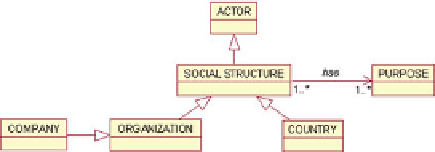Information Technology Reference
In-Depth Information
Social structures are set up by humans in order to fulfill some purpose, typically
to provide value for their environments. For example, the purpose of a school is
to educate people, and the purpose of a car manufacturer is to provide actors with
cars. A special feature that distinguishes social structures from other kinds of rela-
tionships is that they can be actors themselves. The actors who are members of the
social structure can be said to have constructed a higher level actor, which is capable
of performing its own actions.
3.1.3 Purpose
The
purpose
of a social structure is the value it is intended to provide to its
Figure
2
summarizes the relationships between actors, social structures, and
purposes; it also shows some examples of social structures.
Fig. 2
Actors and social
structures
3.2 Actions
3.2.1 Action
An
action
is intentionally carried out by one actor and gives rise to a state change
(partially based on [
12]
, Sect. 3.1.2.1).
A distinguishing feature of an action is that it is always carried out with an inten-
tion to achieve some effect. Events are similar to actions as they also result in effects,
but they happen accidentally or as a result of natural causes, e.g. medical side effects
and earthquakes.
In order to achieve a desired effect, it is often required that several actors together
carry out a number of actions. One example could be a number of workers that
together assemble a vehicle. Another example is a person speaking to another person
who listens to what is said. Only when both the speaker has made his statement and
the listener has heard and understood it, there will be an effect.
3.2.2 Joint Action
A
joint action
is a coordinated set of actions involving the efforts of two or more
actors (taken from [
12]
, Sect. 3.1.2.2).

Search WWH ::

Custom Search